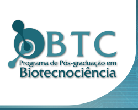Banca de DEFESA: FERNANDO AUGUSTO DE OLIVEIRA
Uma banca de DEFESA de DOUTORADO foi cadastrada pelo programa.DISCENTE : FERNANDO AUGUSTO DE OLIVEIRA
DATA : 24/02/2025
HORA: 09:00
LOCAL: https://conferenciaweb.rnp.br/webconf/fernando-195
TÍTULO:
Molecular Engineering of Polycations towards Gene Delivery
PÁGINAS: 138
RESUMO:
Derivatives of polyethyleneimine (PEI) and of different natural polymers were evaluated as novel vectors for gene delivery aiming at a balance between gene transfection and cytotoxicity. The investigations were focused on arising retinal pigment epithelia (ARPE-19), human hepatocellular carcinoma (HepG2) and HeLa cell lines. The presence of short alkyl domains (C4-C6), and particularly the succinylation of the PEI chains, improved the biological performance of the gene vectors. The presence of hydrophobic units possibly enhances lytic activity, whereas the incorporation of succinic acid slightly reduces polymer-DNA interaction strength, thereby smoothening intracellular unpacking. The succinylation is also supposed to augment protein repelling features. The presence of long carbon chains (for instance, C12), nevertheless, results in higher levels of cytotoxicity and respective lower transfection rates. The sugar-decorated polyplexes are overall less cytotoxic nevertheless, the presence of lactose moieties conducts to larger polyplexes and notably weak polymer-DNA binding, which compromise transfection efficiencies.
Concerning the use of derivatives from natural polymers, the experimental investigations demonstrated that the polysaccharide plays a relevant role in mitigating cytotoxicity, and this is still significantly amplified by the grafting of polyoxazolines. Nevertheless, the polyelectrolyte complexes were evidenced to be inefficient in mediating gene transfection. However, the incorporation of a small amount of PEI in the final samples conducted to transfection levels much higher the for PEI itself at the same concentration. These data underline that gene vectors constructed by blending natural polymers and PEI may remarkably boost the transfection performance of polymeric gene delivery vectors.
MEMBROS DA BANCA:
Presidente - Interno ao Programa - 1768959 - FERNANDO CARLOS GIACOMELLI
Membro Titular - Examinador(a) Interno ao Programa - 1600878 - ARNALDO RODRIGUES DOS SANTOS JUNIOR
Membro Titular - Examinador(a) Externo ao Programa - 1653932 - MARCELO AUGUSTO CHRISTOFFOLETE
Membro Titular - Examinador(a) Externo à Instituição - JULIANA DA SILVA BERNARDES - CNPEM
Membro Titular - Examinador(a) Externo à Instituição - ISMAEL CASAGRANDE BELLETTINI - UFSC
Membro Suplente - Examinador(a) Interno ao Programa - 1601025 - MARCELLA PECORA MILAZZOTTO
Membro Suplente - Examinador(a) Interno ao Programa - 1762438 - JEAN JACQUES BONVENT
Membro Suplente - Examinador(a) Externo à Instituição - MATEUS BORBA CARDOSO - CNPEM




